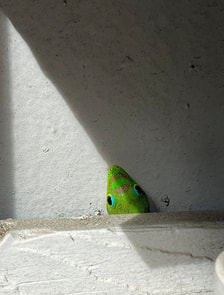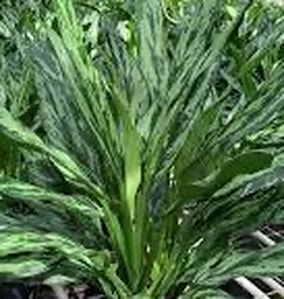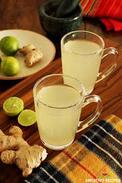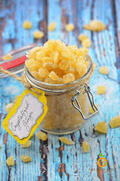| Wonderlight The December dawn is fog filled, And the birds are frosty shadows In the brittle shrubs. Suddenly a dove emerges from the mist. Startling me in the darkness, Her luminous wings flutter just above my crown. I think of the Advent candles Through the long night of the solstice, Like the piercing eyes of the Wise Men, Burning away the darkness, Confronting the unknown. |
At Christmas time, as the weather grows cold, and in many places, snow falls, we seek warm, cozy and well-lighted indoor spaces to enjoy winter’s mysterious beauty. The winter holidays are associated with flickering hearths and outdoor bonfires, candles and shimmering decorations to bring light into our homes as the world outside grows darker and colder.
This is my favorite time of the year for holiday baking, for bringing light and warmth into my home, and filling every space with the comforting scents of winter spices—ginger, nutmeg, cinnamon and cloves.
Christmas is an ancient winter holiday, and many of the familiar holiday cakes, cookies and treats we bake every year originated before electricity and refrigeration became part of human life. Also, winter desserts seldom include fresh fruits or berries, as the growing season for fresh produce is over, though dried fruits, such as raisins, prunes, currants, figs, cherries and apricots are featured in many of our favorite winter foods. Last December, my blog included the recipe for Panforte, an historic dessert which originated in the Eastern Mediterranean region. The ingredients for Panforte, dried fruits, nuts, honey, cinnamon and other spices, do not require refrigeration, and all of them can be stored safely through the long winter months.
In the winter, we also crave spicy foods to warm up the chilly nights. And as a practicality, spices can preserve and lengthen the shelf lives of meats, cakes, cookies and winter fruits and vegetables such as apples, pears, cabbage, beets, carrots and other root vegetables. Spices also add complexity and variety to the taste of winter foods. The ancient Romans discovered spices when they began trading with India in the First Century of the current era. After the fall of the Roman Empire, Marco Polo’s travels along the Spice Road in the 1200s, brought spices from India and China back to Europe. Among the first of these Asian spices to find its way into European cuisine was ginger, my personal favorite.
Ginger is derived from the rhizome, or bulbous root, of a flowering perennial plant, zingiber officinale. Endemic to India and China, this flavorful root has been included in the Southeast Asian diet since the beginning of human history. Ginger grows widely in warm, humid environments, including Hawaii, where fresh ginger root is easy to find in the produce section of every grocery store, but it cannot thrive in the cold winters of Northern Europe. The ginger plant is related to several other tropical spices that have become popular in western cooking, including turmeric, cardamom and galangal. Ginger is now widely exported throughout the world, and India, where ginger is still produced primarily on homestead farms, remains the number one producer of ginger. Nigeria, China, Nepal, Indonesia and Thailand are the other top exporters of ginger.
In Asian cuisine, ginger is used primarily in savory dishes, and the root itself, either peeled and sliced, grated or cut into small matchstick pieces, is used rather than the ground ginger more familiar to Americans. Well known Asian dishes that include ginger root are Chinese vegetable stir fry, Indian Curries, Thai noodle dishes, and Japanese favorites such as sushi and teriyaki. In many Asian food preparations, ginger is combined with garlic and soy sauce. Peeled and uncooked ginger root can also be pickled or candied, but the ground ginger, sold in small, pricey spice jars, is definitely the favorite in European and American Christmas baking.
Like tea and many other Asian herbs, ginger was originally used for medicinal purposes. Even today, ginger is recommended in herbal medicine as a remedy to help relieve the symptoms of nausea, indigestion, morning sickness and even osteoarthritis and heart disease. And for those who would like to enjoy a soothing beverage to ward off the winter cold, it’s easy to make your own ginger tea by pouring hot water over a few slices of peeled ginger root and adding a little honey. It’s a lovely, soothing beverage.
My co-author, Kathleen and I are both devotees of ginger, and our website and blogs are filled with recipes that include ginger in both savory and sweet preparations, as well as spicy winter beverages. In fact, only last month, in her November, 2022 blog, Kathleen shared the procedure for making home-made Pumpkin Pie Spice. The first ingredient in this simple “recipe” is ground ginger, the holiday baker’s best friend. Kathleen has also provided you with the recipe for Gingerbread Cake Mix, also with generous amounts of ginger, so you can make your own luscious Gingerbread Cake for Christmas or any time during the winter season. You can find the recipe in Kathleen’s December, 2020 blog.
In fact, Gingerbread and Fruitcake have been the traditional favorite Christmas Cakes throughout England, Germany and other Northern European countries for centuries. Our website features a variety of recipes for both of these holiday favorites, with some recipes that include ground ginger and others that use chopped candied ginger. Our “California Tea” menu includes Gosby House Gingerbread, served in the lovely Victorian Bed and Breakfast of the same name In Pacific Grove, overlooking the Northern California Coast. This very traditional version includes a tablespoon of ground ginger and dark molasses as well as cinnamon, allspice, cloves and nutmeg for a very dark, sticky and comforting Gingerbread.
Our “Christmas Tea” menu offers Aged Raisin Gingerbread, a blend of old-fashioned Gingerbread and Fruitcake, filled with currents and candied ginger as well as raisins. And at the end of the “Christmas Tea” section of our website, an additional chapter entitled “In Defense of Fruitcake: Fruitcakes and Candied Fruit” provides several different Fruitcake recipes, some containing only dried fruit as well as the procedures for making your own candied fruit, including candied ginger. Our “Christmas Tea” menu also features another holiday favorite of mine that contains candied ginger—Orange Ginger Cookies. I bake these crunchy and chewy delights every year. They age and ship well, filled with chopped almonds, candied orange peel and candied ginger. And finally, for your Christmas feast, my November, 2016 blog shows you how to make your own Cranberry Ginger Sauce, a festive combination of fresh cranberries, chopped candied ginger, orange zest and freshly squeezed orange juice. You will never open a can of cranberry sauce again!
For the crowning glory of your Christmas dinner, I am sharing the recipe for Cranberry Ginger Pound Cake with Candied Cranberries, a favorite with my family which I have baked for Christmas or Thanksgiving many times over the years. This beautiful cake, surrounded by a ring of sparkling candied cranberries, deserves to be presented on your best cake pedestal and served with warm spiced cider on Christmas night.
Cranberry Ginger Pound Cake with Candied Cranberries
I discovered this charming winter holiday Bundt cake recipe thirty-three years ago in the November, 1989 issue of Gourmet magazine. It is everything a Christmas cake should be—colorful, festive, spicy, memorable and warm. The original recipe calls for a glittering cranberry glaze covering the fragrant cake and a whopping two tablespoons of powdered ginger in the batter. I have never quite had the nerve to add both tablespoons of ginger to the batter, and I have adapted the presentation of this cake to include a ring of candied cranberries around the bottom of the cake and a simple caramel icing dripped over the top. The candied cranberries can be made a few days in advance and kept in a covered container. The cake can also be made the day before you plan to serve it, covered, and stored at room temperature. Add the caramel icing and surround the cake with candied cranberries shortly before you serve it. I hope your family will love it.
For the Candied Cranberries:
- 1 (12 ounce) package of fresh cranberries (2½-3 cups,) rinsed and dried
- 1 cup sugar (you can add ½ cup more sugar if you want sweeter candied cranberries)
- Grated zest of 1 lemon
- 2 Tablespoons soft butter
- 2 sticks (1 cup) unsalted butter, at room temperature
- 2 cups sugar
- 4 large eggs, at room temperature
- 2 ½ cups all-purpose flour
- 1 teaspoon baking powder
- ½ teaspoon baking soda
- ½ teaspoon salt
- 1 tablespoon ground ginger
- 1/3 cup buttermilk
- 2 ½ cups fresh cranberries, rinsed and dried
- Baking spray with flour for the pan
- ½ cup brown sugar
- ¼ cup heavy cream
- 3 tablespoons butter
- 7 tablespoons powdered sugar
Special Equipment:
13x9 inch glass baking pan, citrus zester, aluminum foil, wire cooling rack, covered glass container, 12-cup Bundt pan, hand-held electric mixer, large mixing bowl, medium sized mixing bowl, flour sifter or sieve, rubber spatula, bamboo skewer, small saucepan, cake pedestal or decorative platter
Makes: 12 servings
Preheat the oven to 350 degrees F for both the cranberries and the cake
Make the Candied Cranberries:
- Preheat the oven to 350 degrees F. Generously butter a 13x9 inch glass baking pan. Add the rinsed and dried cranberries and arrange them evenly in the pan. Sprinkle 1 cup of sugar and the lemon zest evenly over the cranberries.
- Cover the pan tightly with foil and bake for about 30 minutes. Remove the foil and stir the cranberries. Taste the mixture to test for sweetness. Add ½ cup more sugar if you want sweeter cranberries.
- Replace the foil and bake for an additional 10-20 minutes until the cranberries have released their juices and are surrounded by a thick syrup.
- Remove the pan to a wire cooling rack until the cranberries are completely cooled. Transfer the cranberries and the syrup to a covered glass container and store at room temperature until ready to serve the cake.
Make the Cake:
- Preheat the oven to 350 degrees F. Spray the Bundt pan generously with cooking spray with flour and set aside.
- In a large mixing bowl with an electric mixer, cream the butter and sugar until light and fluffy, about 4 minutes. Add the eggs, 1 at a time, beating well after each addition.
- Using a flour sifter or sieve, sift together the flour, baking powder, baking soda, salt and ginger into a medium sized mixing bowl. Add the flour mixture alternately with the buttermilk to the butter mixture, beginning and ending with the flour mixture, and beating after each addition just until combined.
- Fold the cranberries into the batter with a rubber spatula and spoon the batter into the prepared Bundt pan, smoothing the top evenly. Bake in the pre-heated oven for 50 minutes to 1 hour until a bamboo skewer inserted in the center comes out clean. (Baking times may vary. If using a black-lined Bundt pan, the cake may be done in 45 minutes. Other pans may require more than an hour.)
- Remove the cake from the oven and cool it on a wire rack for 10-15 minutes. With a table knife, gently press the sides of the cake away from the pan and place a decorative platter over the top of the pan. Using potholders, invert the pan over the platter to release the cake. Return the cake to the wire rack to cool completely.
- When ready to serve, transfer the cake to a cake pedestal or leave it on the decorative platter. Surround the bottom of the cake with candied cranberries, sprinkled with additional sugar. Prepare the caramel icing and quickly pour it over the top of the cake, letting it drip over the sides. Serve immediately.
- Combine the brown sugar, cream and butter in a small saucepan. Bring the mixture to a boil and cook over moderate heat, stirring, for 2 minutes. Remove from the heat and let the caramel mixture come to room temperature.
- Using a hand-held electric mixer, beat the powdered sugar quickly into the cooled caramel sauce. Quickly pour the icing directly from the pan over the top of the cooled cake, using a spatula to guide the icing so it covers the top of the cake and drips over the sides. (This icing sets up and becomes firm very quickly, so you will need to work fast while the icing is still pourable.)
















 RSS Feed
RSS Feed